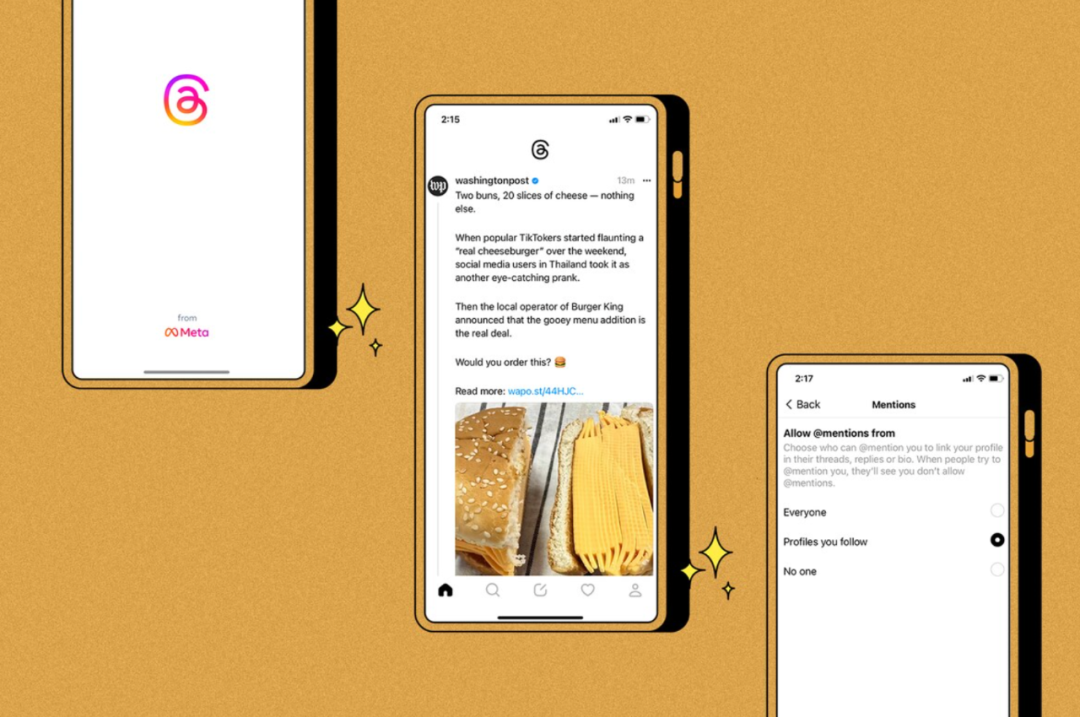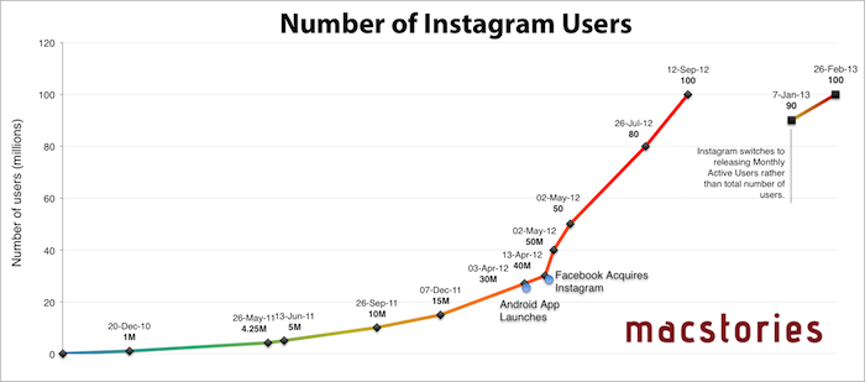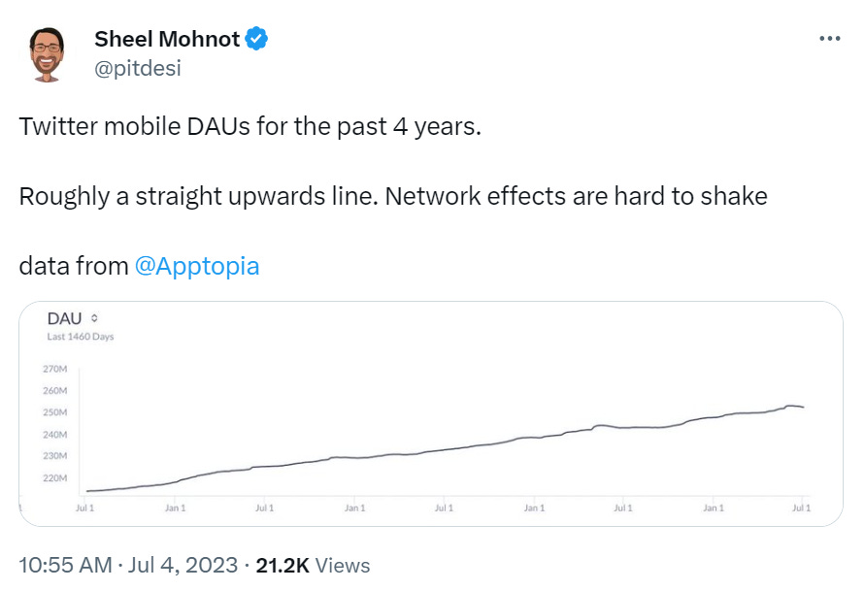Threads, the text-based "Twitter clone", is still a hot topic. It attracted 30 million users in 24 hours, and the following week registered more than 100 million users. This number is obviously not the upper limit of Threads. For Meta, 30 million, only 1-2% of its multi-billion user base, after all, it has not yet used its largest product by users, Facebook.
The launch of Threads will bear the brunt of the crisis and impact on Twitter. More than a decade ago, Twitter stumbled upon some features with strong PMF (product-market fit) and Network Effect, and then built it into a just passable product. It kept its servers running and developed an advertising business that was barely profitable, but it hasn't been able to do more. Until last year, it still had more than 250 million users, while contemporaries WhatsApp, Facebook and Instagram (hereinafter referred to as Instagram) have already surpassed 2 billion each.
As an important voice in politics, media, technology and other industries, Twitter has its irreplaceable position. But we know that as a social network or listed company, it is far from perfect.
Today, Meta is trying to give users a new option.
This article will provide an in-depth but brief analysis of Threads' current rollout and try to answer some questions:
Why is the phased success of Threads inevitable? Should we be optimistic or pessimistic about it? Will its emergence have an impact on the landscape of Twitter, Instagram, TikTok? What is the price/performance ratio for Meta? Did Musk and his Twitter really lose? Does Twitter have a future?
- The phased success of Threads is inevitable, but caution and pessimism are needed
 |
The number of Threads users has exceeded 100 million, which is inevitable under this preparation, especially in the current social environment market, where users urgently need to find a release entrance. The initial success of Threads is partly due to the chaos of Twitter, and Threads itself has some advantages: Threads requires users to have an Ins account, which allows users to register seamlessly (Ins has more than 2 billion users).
In the past two weeks, Meta has published hundreds of "Threads are coming" articles across multiple channels. Everyone who reads the news (one of the main use cases for Twitter) knows the news. Users can pre-install it, so they will receive a push as soon as it goes live. Threads even launched a day earlier than planned, sparking a crazy rush of trials.
Looking at Twitter again, although Musk has been urging celebrities who left Twitter to return, the problem is that most of them also have a large following on Instagram. In the past, the return of celebrities was still possible because Twitter and Instagram were fundamentally different content formats and games (after all, Instagram mainly carries images). But now if they want to try a text-based format, Threads is the best cold start platform.
Building a new network with existing interests and social graphs is one of the smartest things Meta has done. For premium Instagram creators, Threads is easier to start from scratch than Twitter. For average users, familiar celebrities also make them more motivated to get started.
In addition, Threads also borrows from TikTok's recommendation algorithm. Musical.ly founder Alex Zhu once likened starting a new platform to building a new country - if you need to build a new economic system, increase the population, and attract talent from a powerful country. How to effectively provide new opportunities to cultivate new winners? How to pass social capital to the most talented creators through quick guidance and traffic distribution? Refer to TikTok's recommendation algorithm for the answer.
For any era, most of the revenue goes to the earliest users of the platform. As the platform ages, the ascending channel is almost locked, and mining value becomes difficult. TikTok once won a very large new group of people overseas who wanted to win the voice over in social media, and Threads hopes to replicate that success.
In addition to their own efforts, "assists" from Twitter are also one of the driving forces for users to move to Threads. At present, the number of opponents of Twitter is increasing, and many people have contempt and antipathy for Musk, especially journalists and leftists. Some are resisting, others have a desire to find a new home. It should be noted that the builder of the new home, Zuckerberg, has also received a lot of criticism in the past five years. It's a bit like: "The enemy of my enemy is my friend".
Another important factor to ponder is the release timing of Threads. Summer is the peak season for social media posting, as teens have more time to use their phones during the holidays. The three photo products that will be discussed in 2021: Poparazzi, BeReal and Dispo, are also completely broken into other demographics in the summer of that year. Although it also needs to be acknowledged that the current success may be a hidden danger in a few months. As the summer vacation ends, a large number of young users are at risk of losing a lot.
In the eyes of Adam Mosseri, head of Instagram, Threads aims to create a public square for the community and promote a friendlier environment. So how confident is it that it will actually do it?
The advent of the last social platform that rushed into tens of millions of people in a day is a long time ago (the last popular app was Ins, which exploded in 2012). Even the TikTok that the number of users exceeded 1 billion in 2021 was a somewhat niche app in the US at first. Its culture was defined by many trendy Generation Z users, and it was not until later that it was understood and used by a wider circle that it began to form richer cultural characteristics. From this perspective, Threads can be regarded as the first large-scale emerging social platform that millennials have collectively joined in many years.
But in terms of user experience, at least for now, we haven't seen a copycat who is threatening enough to Twitter. Many people who rush to download Threads seem to be trying to pre-empt potential new followers as soon as possible, so much so that Threads is now full of "noise". In recent years, too many people have complained about the algorithmic experimentation forced by social platforms and the unfriendly sequencing of news streams. When the opportunity finally came to do something different on Threads, many people returned to the cliché of pursuing attention, clicks and engagement.
You know, Instagram, TikTok, and Twitter got to where they are today because each platform gives users a unique personality, and whenever you try to deviate, you quickly realize that you need to bring your "brand" back into line.
But to be fair, Threads does not yet see the potential for similar success, and it does not appear to be immune to the challenges encountered by other platforms such as Twitter. "As more and more people come into the platform and they have to enforce moderation policies and start launching branded content partnerships and advertising, Threads will encounter more and more of what we know," says Lia Haberman, who teaches social media marketing at UCLA.
In addition, both Threads DAU and user session length fell last week. According to marketing data firm Sensor Tower, the number of daily active users on Tuesday and Wednesday fell by about 20% compared to the previous Saturday. Threads has many more challenges to face.
- Meta's long overdue counterattack may reverse the suppressed situation
A review of the development of social products in the US in the past two decades can be found: the social networking site Myspace was launched in 2003, and a year later, Facebook, which specializes in users with college email addresses, was launched. Not only did it accurately capture the wave of traffic from desktop to mobile, but it also relied on the News Feed launched in 2006 to capture a large number of users. Myspace usage peaked in 2008, and Facebook officially completed the overtake in 2009. In 2011, the chronological News Feed was phased out. The age of algorithms has officially begun.
Twitter, on the other hand, comes from a completely different evolutionary branch. It was first introduced in 2006 by bloggers and journalists, who used it to report news and express opinions for most of its early days. Since 2009, many subcultures have emerged here one after another.
In fact, over the past decade, Facebook has been a relatively safe algorithmic walled garden, while Twitter has been more like a cultural square - a place where citizens participate in a social, political, and economic experiment. Over time, Twitter has become so culturally and voice over that presidents deliberately rely on it to operate; Facebook continues to run wild, relying on subsidiary applications and multiple use cases to continue to grow, as if building a grand "social empire."
Before Musk bought Twitter, Jack Dorsey's management strategy seemed to be the secret weapon for Twitter to stabilize the situation from 2015 to 2021. He was able to balance enough people with smart enough rules and tolerance, so that different groups could find their own comfortable ways to use them. For example, you can discuss current affairs, discuss art, discuss technology, and minorities can even freely express their dissatisfaction with the power structure of Western society. Most importantly, it has created a lot of very good and lasting memes (memes). Compared to that, Facebook looks gloomy.
Now there are Threads. Meta is clearly trying to replicate its strategy of sniping Snapchat with its Story feature launched in 2016, taking out competitors by precisely mimicking their UI, interactions and use cases and porting them to their own network. There is a precise metaphor - "Threads are like your favorite local restaurant opening a branch at the airport."
Meta has long been familiar with this. As early as its acquisition of Ins in 2012, it was able to effectively use Facebook feeds to help Ins quickly acquire and convert new users. As the chart below shows, studies show that 50-75% of Ins downloads ended up on Facebook in the years after the acquisition. Therefore, for Threads, this large-scale customer acquisition experiment is just another example of the effective growth of Ins more than a decade ago. Since Meta has been able to create opportunities for new users to rise, this time is not difficult.
 |
(Instagram user growth curve)
Not to mention, the copying of stories from Instagram not only played a defensive role against Snapchat, but also greatly accelerated the pace of its own development. After curbing Snap's user growth, Meta also contained the possibility of Snapchat's large profits through its advertising team. All of this seems to be a replica of what Threads is to Twitter today.
Looking further, if this text-based social product has a certain scale, Meta's Ins will also have more room for development to check and balance TikTok - including the introduction of more radical experiments in the direction of pictures and videos, reversing the situation that has been continuously suppressed by TikTok in user growth in the past few years.
Worst of all, even if Threads does not develop well in the end, according to analysts at Evercore , a well-known investment bank, it is still expected to generate $8 billion in revenue by 2025. In contrast, few operating costs (mainly Cloud Service fees) and low maintenance difficulties are not worth mentioning. If it happens to make Musk unhappy, this decision is simply too cost-effective.
- Don't underestimate the stability of Twitter, Musk is far from losing
For Threads, everyone's praise and criticism are mixed. Ellen V Lora, a fashion content creator with more than 460,000 followers on Instagram, says Threads is like a large group chat platform. She says the ability to quickly move followers to Threads makes her feel like a "natural addition" to the platform, and her popularity on Twitter has never grown. Industry insider Brian also said: "Meta's interest-based algorithm is a major problem for me. This has filled my thread with posts from accounts I don't follow, mostly influencers and brands advertising their products. I rarely see posts from real friends. "
Musk quipped: "It's better to be attacked by strangers on Twitter than to be immersed in false happiness on Instagram that masks pain."
What makes Twitter special is its ability to bring together newsmakers, whistleblowers and news . This is also the obstacle for Threads: Twitter is an influential platform where public figures, celebrities and politicians from all walks of life are involved. The atmosphere feels like a conversation worth watching is happening in real time, and users don't want to miss it, and sometimes say they don't want to miss a public crisis.
It should be pointed out that, contrary to many people's claims of "escaping Twitter", people are still using Twitter. Although Twitter has always been seen as a crisis by the outside world, and the conflict with users is increasing day by day, relevant data shows that Twitter DAUs have actually been rising in the past four years, as well as after Musk's acquisition. And Musk has made rapid progress in transforming the company's culture. It seems that Twitter is transforming from a large Listed Company to a "start-up company".
 |
(Twitter DAU Curve 2019-2023)
In "The Rise and Fall of Nations," Manser Olson discusses how and why groups form. One of his key insights is the theory of group inertia, which Olson observes works both before and after an organization is formed. Once a group is formed, it tends to persist even if the collective benefits it brings together are no longer needed.
The same is true of social networks. It is not easy to build quickly. Group inertia is your enemy until you build a community successfully. But after a community is formed, inertia becomes what keeps people alive for a long time. No social network embodies this more than Twitter. Social networks are Path Dependence, and the people who make up the community have come a long way in determining its tone and values, so there is a strong resonance in the group.
Although Twitter has been slow to introduce new features over the years and has not developed commercially, it has provided users with unique value, allowing them to participate in noisy public discussions that cannot be given anywhere else.
This is why some people believe that Instagram and Twitter have never actually been competing products. The mainstream users of the former are beautiful and cool; the fans of the latter are relatively uncool. They may be geeks, they may be , they may be talented, or they may not fit in. Others believe that Twitter has changed the lives of many users, most of them very positive. They made real friends here, discovered great books/podcasts/TV shows/movies, and learned skills.
The history of the internet is not long, and it is a rare experiment to see whether a social network of a certain size and longevity can suddenly lose its vitality in a few years. Historically, social networks have tended to be killed by something foreign (usually another newer social network). But Twitter is special, and many people think it is suicidal.
To be fair, it may not be too optimistic that Musk will succeed in saving Twitter. Most of Musk's early tweets about Twitter's problems blamed engineering and technical problems, such as long response times and frequent bugs, for its poor performance. But Twitter's appeal was never something that technology could bring, and what really kept users here was that there were people they were interested in.
Twitter is not like the SpaceX Musk is familiar with, and the methodology for running it and running a rocket company can be very different. If you run multiple tests on a launch vehicle, success or failure, engineers will get data that will be useful for subsequent test flights, and it won't cause any harm; but running tests on a social media service is a bit like putting users on a rocket. If it crashes, they won't participate in the next test flight.
The most likely outcome imaginable is that Threads will ultimately fail to effectively threaten Twitter. Trying to build new tweets will only lead to a bunch of smaller and smaller forks of the same product for different groups of people to use.
Looking back at every era of the internet, at its end you'll see a whole bunch of forgotten apps that try to suddenly revive to replace those that are dying: Myspace trying to revive itself with a redesign; Vine trying to resurrect as Byte; BeReal trying to reinvent Help users have the simple pleasures that Snapchat once brought them.
But then they will find that the user's taste has changed. The user is moving on, but the products are still in place.
If Twitter's journey is destined to end, we can learn from it an emotional truth: real wealth is the friends we make along the way, and when we can't find those friends in the dark timeline, it is gradually dying.
The new hope for social media may well not be Threads, but the open standard ActivityPub that builds it, as well as Mastodon and Bluesky. If they get enough attention, maybe Twitter will be forced to join the standard so that we can choose our favorite frontend, UI, moderation rules, and recommendation algorithms.
With the launch of Threads, the game has just begun. How far can it go? Can Meta prove itself again? Can Twitter withstand backlash from the giants? Everything is still unknown.